 W
WElectrical wiring is an electrical installation of cabling and associated devices such as switches, distribution boards, sockets, and light fittings in a structure.
 W
WPlugs and sockets for electrical appliances not hardwired to mains electricity originated in the United Kingdom in the 1870s and were initially two-pin designs. These were usually sold as a mating pair, but gradually de facto and then official standards arose to enable the interchange of compatible devices. British standards have proliferated throughout large parts of the former British Empire.
 W
WAluminium conductor steel-reinforced cable (ACSR) is a type of high-capacity, high-strength stranded conductor typically used in overhead power lines. The outer strands are high-purity aluminium, chosen for its good conductivity, low weight, low cost, resistance to corrosion and decent mechanical stress resistance. The centre strand is steel for additional strength to help support the weight of the conductor. Steel is of higher strength than aluminium which allows for increased mechanical tension to be applied on the conductor. Steel also has lower elastic and inelastic deformation due to mechanical loading as well as a lower coefficient of thermal expansion under current loading. These properties allow ACSR to sag significantly less than all-aluminium conductors. As per the International Electrotechnical Commission (IEC) and The CSA Group naming convention, ACSR is designated A1/S1A.
 W
WIn electric power distribution, a bus duct is a sheet metal duct or also cast resin insulated containing either copper or aluminium busbars for the purpose of conducting a substantial current of electricity. It is an alternative means of conducting electricity to power cables or cable bus.
 W
WIn the electrical wiring of buildings, a cable tray system is used to support insulated electrical cables used for power distribution, control, and communication. Cable trays are used as an alternative to open wiring or electrical conduit systems, and are commonly used for cable management in commercial and industrial construction. They are especially useful in situations where changes to a wiring system are anticipated, since new cables can be installed by laying them in the tray, instead of pulling them through a pipe.
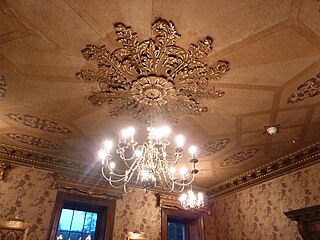 W
WIn the United Kingdom and Australia, a ceiling rose is a decorative element affixed to the ceiling from which a chandelier or light fitting is often suspended. They are typically round in shape and display a variety of ornamental designs.
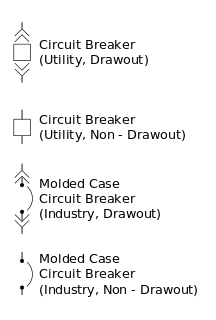 W
WA circuit breaker is an automatically operated electrical switch designed to protect an electrical circuit from damage caused by excess current from an overload or short circuit. Its basic function is to interrupt current flow after a fault is detected. Unlike a fuse, which operates once and then must be replaced, a circuit breaker can be reset to resume normal operation.
 W
WA consumer unit is a type of distribution board.
 W
WCopper has been used in electrical wiring since the invention of the electromagnet and the telegraph in the 1820s. The invention of the telephone in 1876 created further demand for copper wire as an electrical conductor.
 W
WCopper-clad aluminium wire is an electrical conductor composed of an inner aluminium core and outer copper cladding.
 W
WCopper-clad steel (CCS), also known as copper-covered steel or the trademarked name Copperweld is a bi-metallic product, mainly used in the wire industry that combines the high mechanical resistance of steel with the conductivity and corrosion resistance of copper.
 W
WElectrical busbar systems are a modular approach to electrical wiring, where instead of a standard cable wiring to every single electrical device, the electrical devices are mounted onto an adapter which is directly fitted to a current carrying busbar. This modular approach is used in distribution boards, automation panels and other kinds of installation in an electrical enclosure.
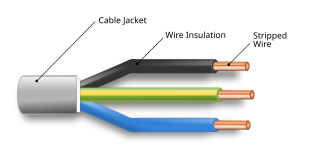 W
WAn electrical cable is an assembly of one or more wires running side by side or bundled, which is used to carry electric current.
 W
WAn electrical conduit is a tube used to protect and route electrical wiring in a building or structure. Electrical conduit may be made of metal, plastic, fiber, or fired clay. Most conduit is rigid, but flexible conduit is used for some purposes.
 W
WAn electrical outlet tester, receptacle tester, or socket tester is a small device containing a 3-prong power plug and three indicator lights, used for quickly detecting some types of incorrectly-wired electrical wall outlets. The tester is easily carried in a pocket, can be used with little training, and can identify some common wiring problems, but it fails to detect certain other dangerous types of wiring defects.
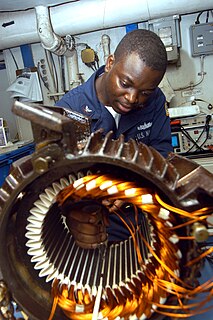 W
WAn electrician is a tradesman specializing in electrical wiring of buildings, transmission lines, stationary machines, and related equipment. Electricians may be employed in the installation of new electrical components or the maintenance and repair of existing electrical infrastructure. Electricians may also specialize in wiring ships, airplanes, and other mobile platforms, as well as data and cable lines.
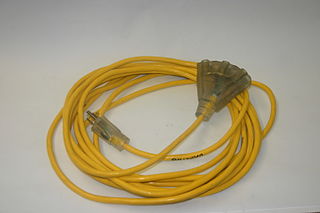 W
WAn extension cord (US), power extender, drop cord, or extension lead (UK) is a length of flexible electrical power cable (flex) with a plug on one end and one or more sockets on the other end. The term usually refers to mains extensions but is also used to refer to extensions for other types of cabling. If the plug and power outlet are of different types, the term "adapter cord" may be used. Most extension cords range from around two to thirty feet in length although they are made up to 300 feet in length.
 W
WIn electronics and electrical engineering, a fuse is an electrical safety device that operates to provide overcurrent protection of an electrical circuit. Its essential component is a metal wire or strip that melts when too much current flows through it, thereby stopping or interrupting the current. It is a sacrificial device; once a fuse has operated it is an open circuit, and must be replaced or rewired, depending on its type.
 W
WIn electrical engineering, ground or earth is a reference point in an electrical circuit from which voltages are measured, a common return path for electric current, or a direct physical connection to the earth.
 W
WHousehold hardware is equipment that can be touched or held by hand such as keys, locks, nuts, screws, washers, hinges, latches, handles, wire, chains, belts, plumbing supplies, electrical supplies, tools, utensils, cutlery and machine parts. Household hardware is typically sold in hardware stores.
 W
WIndustrial and multiphase plugs and sockets provide a connection to the electrical mains rated at higher voltages and currents than household plugs and sockets. They are generally used in polyphase systems, with high currents, or when protection from environmental hazards is required. Industrial outlets may have weatherproof covers, waterproofing sleeves, or may be interlocked with a switch to prevent accidental disconnection of an energized plug. Some types of connectors are approved for hazardous areas such as coal mines or petrochemical plants, where flammable gas may be present.
 W
WKeystone wall plates are used in commercial and industrial buildings to cleanly attach telecommunication cables etc. to a junction box, surface mount box, or a mud ring mounted in the drywall of a building. Keystone wall plates are made to work with many different types of cabling solutions, including coaxial, twisted pair, HDMI, optical fiber, etc. Keystone wall plates are made of plastic and have one to twelve ports. A keystone port is a hole in the wall plate which allows the insertion of a keystone module or other male or female cabling connectors. The most common colors of keystone wall plates are beige and white. Keystone wall plates are commonly made to be compatible with NEMA standard openings and boxes.
 W
WKnob-and-tube wiring is an early standardized method of electrical wiring in buildings, in common use in North America from about 1880 to the 1930s. It consisted of single-insulated copper conductors run within wall or ceiling cavities, passing through joist and stud drill-holes via protective porcelain insulating tubes, and supported along their length on nailed-down porcelain knob insulators. Where conductors entered a wiring device such as a lamp or switch, or were pulled into a wall, they were protected by flexible cloth insulating sleeving called loom. The first insulation was asphalt-saturated cotton cloth, then rubber became common. Wire splices in such installations were twisted together for good mechanical strength, then soldered and wrapped with rubber insulating tape and friction tape, or made inside metal junction boxes.
 W
WMains electricity by country includes a list of countries and territories, with the plugs, voltages and frequencies they commonly use for providing electrical power to low voltage appliances, equipment, and lighting typically found in homes and offices. Some countries have more than one voltage available. For example, in North America most sockets are attached to a 120 V supply, but there is a 240 V supply available for large appliances. Often different sockets are mandated for different voltage or current levels.
 W
WMineral-insulated copper-clad cable is a variety of electrical cable made from copper conductors inside a copper sheath, insulated by inorganic magnesium oxide powder. The name is often abbreviated to MICC or MI cable, and colloquially known as pyro. A similar product sheathed with metals other than copper is called mineral insulated metal sheathed (MIMS) cable.
 W
WA multicore cable is a type of electrical cable that combines multiple signals or power feeds into a single jacketed cable. The term is normally only used in relation to a cable that has more cores than commonly encountered. Not all cables with multiple insulated conductors are called multicore cables – the core in multicore refers to the number of usable connections made, not the number of conductors or wires. In most cases, a "usable connection" requires multiple conductors, such as the positive and negative conductors used for DC power.
 W
WThe National Electrical Code (NEC), or NFPA 70, is a regionally adoptable standard for the safe installation of electrical wiring and equipment in the United States. It is part of the National Fire Code series published by the National Fire Protection Association (NFPA), a private trade association. Despite the use of the term "national", it is not a federal law. It is typically adopted by states and municipalities in an effort to standardize their enforcement of safe electrical practices. In some cases, the NEC is amended, altered and may even be rejected in lieu of regional regulations as voted on by local governing bodies.
 W
WThe National Electrical Contractors Association (NECA) is a trade association in the United States that represents the $171 billion/year electrical contracting industry. NECA supports the businesses that bring power, light, and communication technology to buildings and communities. Through advocacy, education, research, and standards development, NECA works to advance the electrical contracting industry.
 W
WNICEIC is one of several organisations which regulates the training and work of electrical enterprises in the UK. NICEIC is one of several providers given Government approval to offer Competent Person Schemes to oversee electrical work within the electrical industry.
 W
WA power cable is an electrical cable, an assembly of one or more electrical conductors, usually held together with an overall sheath. The assembly is used for transmission of electrical power. Power cables may be installed as permanent wiring within buildings, buried in the ground, run overhead, or exposed. Power cables that are bundled inside thermoplastic sheathing and that are intended to be run inside a building are known as NM-B.
 W
WA power cord, line cord, or mains cable is an electrical cable that temporarily connects an appliance to the mains electricity supply via a wall socket or extension cord. The terms are generally used for cables using a power plug to connect to a single-phase alternating current power source at the local line voltage. The terms power cable, mains lead, flex or kettle lead are also used. A lamp cord is a light-weight, ungrounded, single-insulated two-wire cord used for small loads such as a table or floor lamp.
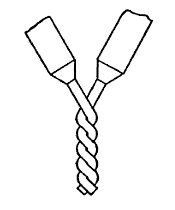 W
WA rat-tail splice, also known as a twist splice or a pig-tail splice, is a very basic electrical splice that can be done with both solid and stranded wire. It is made by taking two or more bare wires and wrapping them together symmetrically around the common axis of both wires. The bare splice can be insulated with electrical tape or other means.
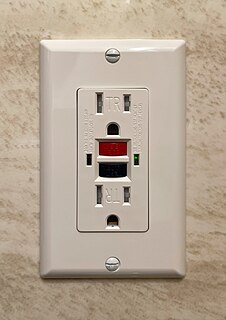 W
WA residual-current device (RCD), or residual-current circuit breaker (RCCB), is a safety device that quickly breaks an electrical circuit to protect equipment and to reduce the risk of serious harm from an ongoing electric shock. Injury may still occur in some cases, for example if a human receives a brief shock before the electrical circuit is isolated, falls after receiving a shock, or if the person touches both conductors at the same time.
 W
WStar-quad cable is a four conductor cable that has a special quadrupole geometry that provides magnetic immunity when used in a balanced line. Four conductors are used to carry the two legs of the balanced line. All four conductors must be an equal distance from a common point. The four conductors are arranged in a four-pointed star. Opposite points of the star are connected together at each end of the cable to form each leg of the balanced circuit.
 W
WIn electrical wiring, a T-splice is a splice that is used for connecting the end of one wire to the middle of another wire, thus forming a shape like that of the letter "T." This splice can be used with solid or stranded wires. The existing wire is called the main wire. The new wire that connects to the main wire is called the branch wire or tap wire. This is a prevalent junction type used in knob and tube wiring.
 W
WAs a former British colony and territory, technical standards in Hong Kong of today has been largely influenced by that of the United Kingdom, with some exceptions due to local and practical considerations.
 W
WTeck cable is a type of low voltage armoured cable named for the location where it was first developed and used, Teck Township, now known as Kirkland Lake, Ontario. The mining operations such as those conducted by Teck-Hughes Gold Mining Ltd. required a durable cable to power equipment and withstand the demanding conditions, and teck cable was the engineered result.
 W
WThree-phase electric power is a common type of alternating current used in electricity generation, transmission, and distribution. It is a type of polyphase system employing three wires and is the most common method used by electrical grids worldwide to transfer power.
 W
WTwist-on wire connectors are a type of electrical connector used to fasten two or more low-voltage electrical conductors. They are widely used in North America and several European countries in residential, commercial and industrial building power wiring, but have been banned in some other jurisdictions.
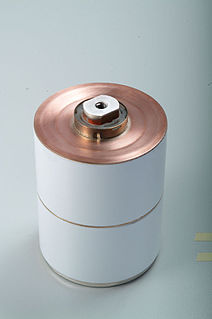 W
WIn electrical engineering, a vacuum interrupter is a switch which uses electrical contacts in a vacuum. It is the core component of medium-voltage circuit-breakers, generator circuit-breakers, and high-voltage circuit-breakers. Separation of the electrical contacts results in a metal vapour arc, which is quickly extinguished. Vacuum interrupters are widely used in utility power transmission systems, power generation unit, and power-distribution systems for railways, arc furnace applications, and industrial plants.
 W
WThe Western Union splice or Lineman splice is a method of joining electrical cable, developed in the nineteenth century during the introduction of the telegraph and named for the Western Union telegraph company. This method can be used where the cable may be subject to loading stress. The wrapping pattern design causes the join to tighten as the conductors pull against each other. This type of splice is more suited to solid, rather than stranded conductors.
 W
WA wiring closet is a small room commonly found in institutional buildings, such as schools and offices, where electrical connections are made. While they are used for many purposes, their most common use is for computer networking where it may be called a premises wire distribution room. Many types of network connections place limits on the distance between end user equipment, such as personal computers, and network access devices, such as routers. These restrictions might require multiple wiring closets on each floor of a large building.
 W
WA wiring diagram is a simplified conventional pictorial representation of an electrical circuit. It shows the components of the circuit as simplified shapes, and the power and signal connections between the devices.
 W
WZip-cord is a type of electrical cable with two or more conductors held together by an insulating jacket that can be easily separated simply by pulling apart. In Australia it is known as 'figure-8' cable. The zip-cord term is also used with optical fiber cables consisting of two optical fibers joined in a similar manner. The design of zip-cord makes it easy to keep conductors that carry related electrical or optical signals together and helps avoid tangling of cables. Typical uses include lamp cord and speaker wire. Conductors may be identified by a color tracer on the insulation, or by a ridge molded into the insulation of one wire, or by a colored tracer thread inside the insulation. Zip cords are intended for use on portable equipment, and the US and Canadian electrical codes do not permit their use for permanently installed wiring of line-voltage circuits.